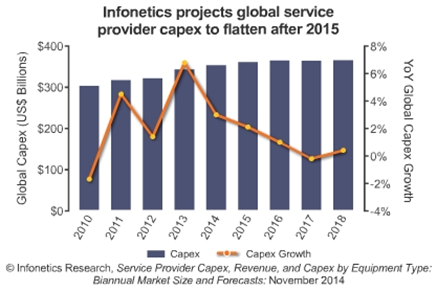 Infonetics Researchでモバイルインフラとキャリア経済を担当する主席アナリスト、Stéphane Téral氏は次のように語る。「全体的に見て、テレコム事業の収益の伸びはあらゆる地域で鈍化し続けています。欧州の5大サービス事業者であるDeutsche Telekom、Orange、Telecom Italia、Telefónica、Vodafoneも過去3年間ほど声高に語られないものの、収益の減少に見舞われ続けています。また、北米のAT&TやVerizonは、T-Mobile USが口火を切ったモバイルサービスの価格戦争によって収益が減少していることを示唆しています。
Infonetics Researchでモバイルインフラとキャリア経済を担当する主席アナリスト、Stéphane Téral氏は次のように語る。「全体的に見て、テレコム事業の収益の伸びはあらゆる地域で鈍化し続けています。欧州の5大サービス事業者であるDeutsche Telekom、Orange、Telecom Italia、Telefónica、Vodafoneも過去3年間ほど声高に語られないものの、収益の減少に見舞われ続けています。また、北米のAT&TやVerizonは、T-Mobile USが口火を切ったモバイルサービスの価格戦争によって収益が減少していることを示唆しています。Infoneticsで企業ネットワークを担当するアナリストであり、レポートの共同執筆者でもあるMatthias Machowinski氏はこうつけ加える。「低調な2013年の後、2014年には企業ネットワーク・通信の収益成長が加速しました。これは北米市場が復活し、セキュリティーインフラへの投資が増大したおかげです。当社は2015年も同様の結果になると予想していますが、北米・アジア太平洋地域における強力なエンドユーザーからの需要が欧州での景気減速によって相殺される可能性もあります。」 テレコムおよびデータコム市場の動向
- マクロ経済指標が示唆するところでは、引き続き低調なユーロ圏と大幅に減速したブラジルとロシアの影響で、2014年通年の世界経済の成長率は3%と緩やかなものになる。
- 2014年第1四半期 (1H14) の世界のモバイルサービスの収益は、再び欧州に引きずられる形で、前年同期比0.5%増とかろうじて微増した。
- スマートフォン利用の増加に牽引され、モバイルデータサービス (テキストメッセージ、モバイルブロードバンド) は2014年第1四半期にすべての地域で再び上昇した。
- モバイルブロードバンドサービスは前年比26%成長し、SMSによる収益の減少を相殺するのに十分だった。
- 企業ネットワーク・通信市場に影響を与えるものには主に、クラウドサービスの採用、企業のデータセンターにおけるクラウド アーキテクチャの利用、あらゆるIT関係の決定の一部となっているセキュリティーなどの動向がある。
Telecom Revenue Growth Stalls as Datacom Growth Accelerates - New Infonetics Global Market Trends Report Campbell, CALIFORNIA, January 12, 2015-Infonetics Research, a technology market research firm, today released excerpts from its latest Global Telecom and Datacom Market Trends and Drivers report. In the report, Infonetics, now part of IHS Inc. (NYSE: IHS), analyzes global and regional market trends and conditions. "Overall, growth in telecom revenue continues to slow in every geographic region. Europe's 5 largest service providers-Deutsche Telekom, Orange, Telecom Italia, Telefónica, and Vodafone-continue to experience declining revenue, though less pronounced than in the past 3 years. And in North America, AT&T and Verizon have signaled that the mobile services price war started by T-Mobile US is taking a bite," says Stéphane Téral, principal analyst for mobile infrastructure and carrier economics at Infonetics Research.
Co-author of the report Matthias Machowinski, Infonetics' directing analyst for enterprise networks, adds: "After a weak 2013, enterprise networking and communication revenue growth accelerated in 2014 thanks to a resurging North American market and stepped-up investments in security infrastructure. We expect similar results in 2015, when strong end-user demand in North America and Asia Pac is likely to be offset by a slowdown in Europe." TELECOM AND DATACOM MARKET TRENDS
- Macroeconomic indicators point to moderate global economic growth of 3 percent for the full-year 2014 due to persistent weaknesses in the Eurozone and a significant slowdown in Brazil and Russia
- Global mobile service revenue barely budged in the first half of 2014 (1H14), up just 0.5 percent from the same period a year ago, badly dragged by Europe again
- Mobile data services (text messaging and mobile broadband) rose again in every region in 1H14, driven by the increasing usage of smartphones
- Mobile broadband services grew 26 percent year-over-year, enough to offset the decline of SMS revenue
- Key trends affecting the enterprise networking and communication markets include the adoption of cloud services, the use of cloud architectures in enterprise data centers, and security becoming a part of every IT decision

